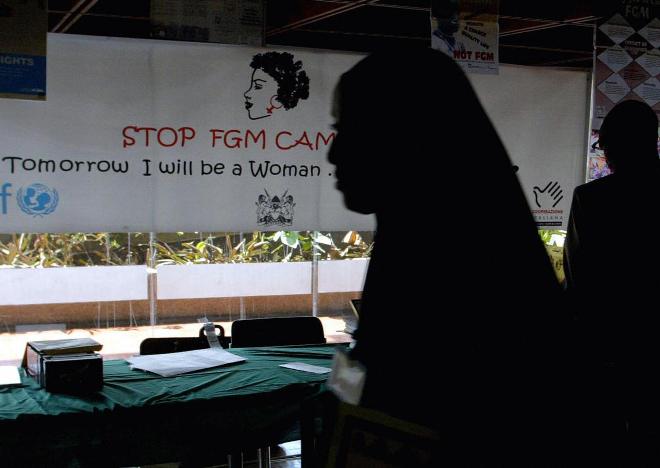
Wednesday October 11, 2017

A YOUNG WOMAN WALKS PAST A CAMPAIGN BANNER AGAINST FEMALE GENITAL MUTILATION. (SIMON MAINA/AFP/GETTY IMAGES)
Istar was 15 when she was married off to a man in his 70s in Puntland, Somalia. Her “price” was a gun and 10 camels. As a young girl, Istar had undergone female genital mutilation (FGM) in its most severe form, infibulation, which leaves girls with their labia stitched together following removal of the clitoris.
When her husband was unable to penetrate her following the wedding, he cut her open with a dagger. The cut went deep and she started to bleed profusely.
After receiving emergency medical attention Istar got longer-term support from the Galkayo Center in Puntland, Somalia and she is hopefully in the process of making a full recovery. She is one of more than 200,000 girls who have been helped at the center, which was set up in 1999 and is run by Hawa Aden Mohamed, a shining light for Somali girls.
African women have been leading the movement to end FGM for many decades. Hawa has risked abuse and faced death threats for the benefit of girls in her home country. Her work is painstaking. Changing attitudes and getting governments to ban FGM — or to enforce bans on FGM — can take many years in some instances.
The reality is that protecting girls and ensuring they are not disempowered through FGM, child marriage or other forms of violence has a positive impact on everyone. Providing safety and nurturing the empowerment of girls enables them to live up to their full potential and benefits families and communities as well.
In neighboring Kenya, long-term campaigner Agnes Pareyio also set up the Tasaru Rescue Center in 1999. Buoyed on by her determination and clear focus on the promotion of the rights of girls, the government set up an anti-FGM board, an emergency helpline for girls, and made sure that the police are properly trained to protect those at risk from FGM.
According to the Kenyan Demographic and Health Survey, within a relatively short time frame the prevalence rate has fallen from more than 40 percent for middle-aged women to 11 percent for teenage girls. This is the fastest decline for any country in the world.
We are finally in a position where we have reliable data on what works in countries where FGM is prevalent. UNICEF’s regular reports — most recently in 2016 — show that some countries have been more successful than others in ending it. Alongside Kenya, Liberia has managed to reduce FGM from 72 percent to 31 percent. In Burkina Faso, it has gone down from 89 percent to 58 percent. All three of these countries have a growing movement toward empowering girls alongside relatively high levels of government commitment to address the issue.
Not everywhere has been so successful. We have seen that where the empowerment of girls on the ground does not take place — and where government commitment is lacking — FGM continues. Change has been slower to materialize in Somalia, a country where political instability and conflict has meant that it has been difficult to pass and implement FGM bans. In Somalia, 98 percent of girls and women over the age of 15 have been mutilated. However, the impact of Hawa’s life-changing work is likely to be seen soon as younger girls grow up with greater awareness and a determination to end the harmful practice of FGM.
It is also important that any funds which are available are used efficiently. Unlike most countries, Senegal has received relatively higher levels of funding to end it — particularly to one group. However, prevalence has only fallen marginally from 29 percent to 24 percent and the attitudes of younger girls toward ending FGM has barely improved either according to UNICEF. Part of the reason is probably that funding did not get to where it is most needed and the Senegalese approach does not seem to prioritize prosecutions, prevention and protecting all girls at risk.
Today is International Day of the Girl. Having supported front-line African activists working on this issue for decades, I hope that we can finally start to get funding to these activists on the front lines.
They are most successful at ending FGM — they know how to change hearts and minds in their own communities. There is clearly a growing commitment by governments such as Canada, which published a feminist aid policy this summer that promised $150 million would go directly to organizations in the Global South. The Gates Foundation also recently pledged $20 million to front line women’s groups. We hope other governments and foundations follow suit.
As with all work to empower women and girls progress to date has been slow on this type of direct funding to end FGM. In 2013, the U.K. government committed £35 million, the largest-ever amount by any government to end FGM specifically, yet it appears that little has reached front line groups.
If we are to really empower the next generation of girls and support societies to change their laws, attitudes and behaviors on FGM as well as achieve the promise to end FGM for good that every leader made when they committed to the U.N. Sustainable Development Goals, we have to start funding groups like the Tasaru Rescue Center and the Galkayo Center who know how to end FGM and are building the movement for change from the roots up. Accelerating their work will save girls’ lives and bring us ever closer to the day when FGM is consigned to the pages of history, where it belongs.
To celebrate International Day of the Girl and raise awareness, Donor Direct Action, part of the #FreedomForGirls Campaign organized by Project Everyone launching on October 11, produced a video of young girls dancing to Beyoncé’s “Freedom.” Watch it below.